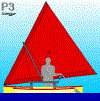| by Othmar Karschulin karschulin@multihull.de
I'm a communication designer who has been sailing for 30 years. My favorites
have always been multihulls, and more specifically pacific outriggers.
Following is my entry for the Duckworks Magazine Design Contest.
Essentials
| Length overall: |
3,00 m |
| Length waterline: |
3,00 m |
| Beam overall: |
1,60 m |
| Draught: |
0,18 m |
| (board up): |
0,45 m |
| Displacement: |
130 kg |
| Weight: |
~ 45 kg |
| Sail area: |
5,25 sqm |
Principles
The P3 is a lightweight minimal outrigger which fits into the 10' class. This is a race class from Italy which founded
in a minimal cartoppable boat for little Fiat cars.
With a beam of 1,60 m the P3 may carried complete fitted on a car top. To disassemble/assemble the boat,
only 4 girdles are needed, which press the beams onto the beam holders.
The sailor could sit on a few planks which lay over the T-Beams.
He can put his feet into the little cockpit, so that relative comfort is
achieved.
Building
 The P3 can build in the well known stitch & glue method from plywood without a lot of material as a basis.
Flat ground is enough. All plates and parts are glued with epoxy. All edges could be reinforced with fiberglass.
To fulfill the contest rules the decks of Vaka (mainhull) and Ama (small hull) are covered with Polytarp - for later
race entry this should be replaced by plywood. All parts are not drawn onto the plywood sheets must be made
from the other given material. So eg. the beams, beam holders, mast, stringer, etc. The P3 can build in the well known stitch & glue method from plywood without a lot of material as a basis.
Flat ground is enough. All plates and parts are glued with epoxy. All edges could be reinforced with fiberglass.
To fulfill the contest rules the decks of Vaka (mainhull) and Ama (small hull) are covered with Polytarp - for later
race entry this should be replaced by plywood. All parts are not drawn onto the plywood sheets must be made
from the other given material. So eg. the beams, beam holders, mast, stringer, etc.
Rig
To go fast speed with such a little boat with a low displacement, it needs a rig which brings lift into the system. Therefore a
genuine Crab Claw Sail is the best choice. The contest version gets a sail area of 5,25 sqm
dictated by the allowed poles.
Experience says that the Crab Claw Sail corresponds with a Bermuda rig
about 150 percent bigger. This means 5,25 sqm corresponds about 8 sqm - a lot of sail area for such a small boat. The race
model will have 6,5 sqm sail.
The spars are made from the two wood poles 1-1/2" dia. The mast is made for the
contest rules from the 5,0 x 10,0, later all could be made from surf masts or from bamboo.
Sailing
As a pacific proa the P3 shunts, that means the wind comes always from the same (outrigger) side.
Therefor for changing the sailing direction the tack of the sail must
be shifted to the other bow. To do this, the tack is guided by a line which runs from bow to bow.
Additionally the rudder (if only one is used) must put into the opposite support. The mast is fixed by two shrouds which run
as wide as the mast bends, then stop with a knot at a ring. In the race version the mast is
held during shunting with shock cords. This wasteful action of shunting should be counterbalanced
by the speed between these maneuvers.
In every case it will be an adventure to sail this tricky thing.
Illustrations
click to enlarge
|
![]()